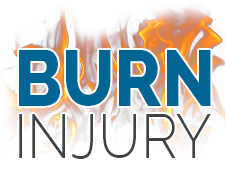Burn Treatment
Burn treatment will depend on the severity of the patient’s burn. First degree burns can typically be treated without professional medical attention. Patients who undergo second, third, and fourth degree burns should seek professional medical burn treatment to ensure adequate recovery and minimize scarring and other burn injury complications. Severe burn patients who do not receive proper treatment may develop infections or other life-threatening complications.
After a Burn
Immediately after a burn, victims should take appropriate steps to either treat the burn or prepare and protect the burn until the patient can receive medical attention. Any burns that occur near the eyes should be treated by a professional, regardless of the degree.
First Degree Burn Treatment
When a first degree burn occurs, patients should run the burned area under cool water for five to ten minutes, or apply a cool compress to the area. Ice should not be applied as it may increase damage to the area. Butter, oil, egg whites and other “home remedies” should also be avoided.
Second Degree Burn Treatment
Second degree burn blisters should not be broken, as this increases the risk of infection. If clothing is stuck to the skin, it should be left intact and removed by a medical professional only. Is possible, the burned area should be elevated above the heart.
Third and Fourth Degree Burn Treatment
Victims or witnesses should call emergency medical help as soon as possible. Witnesses should check the burn victim to ensure that airways are functioning and that breathing or circulation has not been affected. Clothing stuck to the skin should not be removed. The burn area should be covered with a cool, sterile, and moist bandage or clean cloth until help arrives.
Hospitalization
When a burn patient is admitted into a hospital, the first step in burn treatment is to stabilize the patient. This may involve stabilizing drugs and intravenous fluid, depending on how much fluid the patient may have lost due to the burn injuries. Patients with burns covering 20 percent or more of the body typically require IV fluids as soon as possible.
Skin Graft Surgery
If the damage is severe, the patient may need to undergo skin graft surgery. Skin graft surgery involves taking healthy skin from another area on the body and transplanting it onto the burned area. Skin grafts may either be split-thickness or full-thickness. Split-thickness skin grafting uses the top two layers of skin: the epidermis and the dermis. For more severe burns, full-thickness skin grafts also include the transplant of muscles and blood supply.
Sources:
“Burn Treatment.” Surgical Products Oct. 2001: 34. Academic OneFile. Web. 27 Dec. 2013.
“Healing By the Skin of One’s Seeds.” Science News 121.5 (1982): 73. Academic Search Complete. Web. 27 Dec. 2013.
Pegg, S P. “Burn Treatment.” The Australian and New Zealand Journal of Surgery 68.10 (1998): 689. MEDLINE with Full Text. Web. 27 Dec. 2013.
Xu, Rong Xiang, Xia Sun, and Bradford S. Weeks. Burns Regenerative Medicine and Therapy. Basel: Karger, 2004. eBook Collection (EBSCOhost). Web. 27 Dec. 2013.













